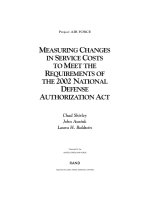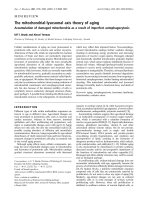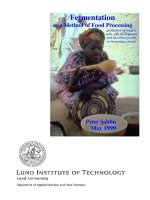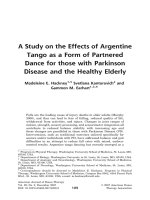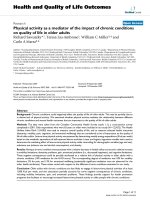Changes in soil physical properties as a result of different land use systems with depth
Bạn đang xem bản rút gọn của tài liệu. Xem và tải ngay bản đầy đủ của tài liệu tại đây (165.06 KB, 5 trang )
Int.J.Curr.Microbiol.App.Sci (2018) 7(1): 323-327
International Journal of Current Microbiology and Applied Sciences
ISSN: 2319-7706 Volume 7 Number 01 (2018)
Journal homepage:
Original Research Article
/>
Changes in Soil Physical Properties as a Result of Different Land Use
Systems with Depth
V.P. Bhavya*, S. Anil Kumar, Ashok Alur, M. Shivanna and K.M. Shivakumar
Department of Soil Science and Agricultural Chemistry, College of Horticulture,
Bengaluru-560 065, Karnataka, India
*Corresponding author
ABSTRACT
Keywords
Land use systems,
Organic matter
accumulation, Bulk
density, Total
porosity, Maximum
water holding capacity
Article Info
Accepted:
04 December 2017
Available Online:
10 January 2018
The main objective of this study was to assess the physical properties of the soil under
different cropping systems within the same locality and interpret the results with reference
to organic matter accumulation in soil with twenty year old cultivated crops. The soil
samples were collected from different depths at 0- 15 cm, 15-30cm, 30-50cm and 50100cm from a cashew, mango, rose, vegetable and medicinal and aromatic cropping
systems and analysed for bulk density, water holding capacity and percentage of pore
space. Water holding capacity and percentage of pore space recorded maximum in the
surface layer whereas the bulk density recorded maximum in the subsurface layer of the
soil. Among different land use systems, vegetable block had higher bulk density values
and lowest values was recorded under the mango and cashew orchard whereas, the
maximum water holding capacity and percentage of pore space was higher under the
perennial crops and lowest values was recorded under the annual crops. It was found that
the continuous addition of organic matter under perennial crops helps to increase the
physical properties of the soil and maintain the soil health as compared to annual crops.
organic matter (SOM), their
constituent minerals and porosity.
Introduction
Soils are composed of solids (minerals and
organic matter), and pores which hold air and
water. The bulk density of a soil sample of
known volume is the mass (or weight) of that
sample divided by the bulk volume.
The "ideal" soil would hold sufficient air and
water to meet the needs of plants with enough
pore space for easy root penetration, while the
mineral soil particles would provide physical
support and plant essential nutrients. Bulk
density is influenced by the amount of soil
texture,
The term SOM has been used to encompass all
organic materials found in soil (Stevenson,
1994), excluding charcoal (Oades, 1988) and
partial decomposed products and non-decayed
plant and animal tissues (McCarthy et al.,
1990). It ranged from as low as < 0.5 per cent
carbon in Aridisols to 33 per cent in Histosols
(Sombroek et al., 1993). The organic fraction
can exert a profound influence on soil
properties
and
ecosystem
functioning
(Baldock and Nelson, 2001).
323
Int.J.Curr.Microbiol.App.Sci (2018) 7(1): 323-327
Soil organic carbon (SOC) has been
recognized as the sensitive indicator of
sustainability of an ecosystem (Doran, 2002).
Long term studies have shown the benefits of
manures, adequate fertilization and crop
rotation
in
maintaining
agronomic
productivity by increasing the C inputs into
soils (Reeves, 1997). The maintenance of
adequate levels of SOM through application of
crop residues, green manures, FYM and biosolids are important in maintaining the soil
fertility and sustainable production.
Soil organic matter is the primary source of,
and a temporary sink for, plant nutrients in
cultivated soils. Its importance in maintaining
soil tilth, aiding the infiltration of air and
water, promoting water retention, building soil
aggregation, and controlling the fate of
applied pesticides is well known (Srinivasan et
al., 2012).
Growing of perennial horticulture crops is one
of the strategies to improve soil conditions
which would result in enhancing soil attributes
and contributing to the good health of the soil.
Although the benefits of perennial horticulture
crops on soil in improving its physical
properties have been well known, information
on the changes that would take place on
shifting from one farming system to another
farming system is lacking.
The present study is a modest attempt to
assess the soil physical properties under
diverse horticultural cropping systems. This
study is not intended to convey, that only
perennial horticulture crops is good. However,
it is an impartial assessment of the advantages
and disadvantages of annual and perennial
crops cultivation.
carried out at division of horticulture, UAS
Campus, GKVK, Bengaluru, Karnataka
during 2015. The soil of the experimental site
was sandy loam and classified as fine, mixed
isothermic Kandic Paleustalf of Vijayapura
soil series. Horticultural crops viz., mango,
cashew, rose, vegetable and medicinal and
aromatic crops (Sugandhavana) were selected
for the experiment within the same locality.
The experimental plots were permanently laid
out for specified crops. Soil samples were
collected from four different depths i.e., 0-15,
15-30, 30-50, and 50-100 cm. In addition, soil
cores were collected using core sampler for
the determination of bulk density of the soil.
Soil samples were processed by drying under
the shade, powdering with a clean wooden
mallet and passing through a 2 mm sieve. The
processed samples were stored in polyethylene
bags for analysis in the laboratory. The
statistical analysis was done by using
Randomized
Complete
Block
Design
(RCBD).
Analysis of soil samples for physical
properties
Bulk density of soil sample was determined by
using core sampler technique (Black, 1965)
recording the fresh weight of the sample in the
field and dry weight of the sample in the
laboratory. Drying of soil was done in hot air
oven to constant weight. Bulk density was
calculated as dry weight of soil per unit
volume of the core collected by the core
sampler in the field.
Keen Raczkowski cups were used for
measurement of maximum water holding
capacity of soil as outlined by Piper (1966).
Materials and Methods
In order to achieve the objective of the
experiment, the present investigation was
The pore space of a soil is that portion of the
soil volume occupied by air and water and is
calculated by using the below formula.
324
Int.J.Curr.Microbiol.App.Sci (2018) 7(1): 323-327
PS = Vp/Vt or PS = [1 - (Db/ Dp)]
Where:
Vp = Volume of the pores *
Vt = Total volume of the sample, pore volume
+ solid volume (cm3).
*Vp is difficult to measure, so it is more
common to calculate PS from Bulk density
and particle density.
Results and Discussion
Bulk density under different land use
systems
Bulk density at different depths as influenced
by different horticulture crops is presented in
Figure 1.
Bulk density of a soil is a dynamic property
that varies with the soil structural conditions.
In general, it increases with profile depth due
to changes in organic matter content, porosity
and compaction. Bulk density of the soil
changed significantly over years of cultivation
of perennial and annual crops. It was found
that the higher bulk density values were
recorded in the subsurface layers of the soil
(50-100 cm) as compared to surface layers and
it was observed that bulk density was
increased with increase in soil depth.
Among different cropping systems, the
medicinal and aromatic block (1.56 Mg cm-3)
had higher bulk density followed by vegetable
block (1.55Mg cm-3) and significantly lowest
values were recorded under the mango orchard
(1.50Mg cm-3) at 50-100cm soil depth. This is
due to the continuous addition of organic
matter with minimum tillage treatments under
perennial crops reduces the breakdown of soil
aggregates which helps to reduce the bulk
density. However in case of annual crops due
to continuous cultivation, the soil aggregates
are broken down into small soil particles, as
the size of the soil particles decreases the bulk
density increases.
Fig.1 MO- Mango Orchard, VB- Vegetable Block, CO- Cashew Orchard, MAP’s- Medicinal and
Aromatic Plants, RB- Rose Block
325
Int.J.Curr.Microbiol.App.Sci (2018) 7(1): 323-327
Table.1 Maximum water holding capacity (MWHC) at different depths as influenced by
different horticulture crops
Horticulture land use system
Mango orchard
Cashew orchard
Rose block
Vegetable block
Medicinal and aromatic block
SEm ±
CD at 5%
0-15 cm
43.51
42.88
39.41
36.41
37.19
2.01
6.22
MWHC (%)
15-30 cm 30-50cm
42.41
41.00
41.25
41.00
39.21
38.96
36.00
35.93
36.28
36.00
2.11
1.68
6.33
4.97
50-100cm
40.24
40.11
38.90
35.41
35.26
1.51
4.66
Table.2 Pore space percentage at different depths as influenced by different horticulture crops
Horticulture land use system
Mango orchard
Cashew orchard
Rose block
Vegetable block
Medicinal and aromatic block
SEm ±
CD at 5%
0-15 cm
50.62
52.35
49.23
46.75
48.51
2.33
5.89
Pore space (%)
15-30 cm 30-50cm
48.44
46.71
49.86
48.13
48.13
47.37
45.31
45.00
47.00
46.31
1.22
0.96
4.22
2.86
50-100 cm
45.71
46.51
46.00
44.34
45.32
0.67
2.00
orchard (52.35%) showed significant results
which is on par with mango orchard (50.62%).
The lowest pore space percentage was observed
in vegetable block (46.75%).
Maximum water holding capacity (MWHC)
under different land use systems
The maximum water holding capacity (MWHC)
of the soil differs at varied depth, the MWHC
value of surface soil (0-15 cm) was slightly
higher than subsurface (30-50 cm and 50-100
cm) layer. Among different land use systems,
mango orchard had higher water holding
capacity (43.51%) which is on par with cashew
orchard (42.88%). However, lowest MWHC
was observed under vegetable block (36.41%).
The maximum water holding capacity and pore
space percentage was higher in the perennials
crops as compared to the annual crops in the 015cm soil depth (Table 1 and 2). This is due to,
it is well known that the moisture retention
capacity of the soil is directly related to the total
porosity and indirectly related to the bulk
density. The continuous addition of organic
matter under perennials crops helps in
maintaining the soil structure, soil texture (sand,
silt and clay) and reduces the soil crust
formation thus increases the micro pores and
macro pores in soil which helps to increase the
moisture retention capacity of the soil in surface
layers. As the depth increases, there will be
more compaction in the soil as compared to
surface layers which decreases the water
Pore space percentage under different land
use systems
The pore space percentage is slightly higher in
the surface layers i.e., in 0-15 cm depth than
subsurface layer of the soil i.e., 30-50 cm and
50-100 cm. The percentage of pore space was
slightly decreased with increase in depth.
Among different cropping systems, the cashew
326
Int.J.Curr.Microbiol.App.Sci (2018) 7(1): 323-327
holding capacity. The WHC increases with
increasing the level of organic carbon and clay
(Ramesh et al., 2008).
Dagar, J.C., Moniga, A.D. and Singh, N.T.,
1995. Degradation of tropical rain forest
soils upon replacement with plantations
and aerable crops in Andaman and
Nicobar Islands in India. Trop. Ecol., 36:
89-101.
Doran, J, W., 2002. Soil health and global
sustainability: Translating science into
practice. Agri. Ecosys. Environ, 88: 119127.
Oades, J. M., 1988. The retention of organic
matter in soils. Biogeochem, 5: 35-70.
Piper, C. S., 1966. Soil and Plant Analysis.
Hans Publishers, Bombay.
Ramesh, V., Ballol, S. S., Sharma, K. L.,
Kausalya, R., Korwar, G. R. and
Ramakrishna,
Y.
S.,
2008.
Characterization of soil for physical
properties under different land uses
systems. Indian J. Dry land Agric. Res.
Dev. 23(1): 102-109.
Reeves, D. W., 1997. The role of soil organic
matter maintaining soil quality in
continuous cropping systems. Soil & Till.
Res., 43: 131-167.
Shankar, M.A., Manjunatha, A., Gajanana, G.
N., Pandurangaiah, K. Lingappa, B. S.,
Mariraju, H. and Indrakumar, N., 2003.
Three Decades of Dryland Agricultural
Research for Alfisols of South Karnataka
(1971-2000). AICRP for Dryland
Agriculture, UAS, Bangalore.
Sombroek, W.G., Nachtergaele, and Hebel, A.,
1993.
Amounts,
dynamics
and
sequestering of carbon in tropical and
subtropical soils. Ambio, 22: 417-426.
Srinivasan, V., Maheswarappa, H. P. and Lal,
R., 2012. Long term effects of topsoil
depth and amendments on particulate and
non-particulate carbon fractions in a
Miamian soil of Central Ohio. Soil Till
Res, 121: 10-17.
Addition of litter biomass might have altered
distribution of micro and macro-pores and thus,
helped the soil to retain more water (Dagar et
al., 1995). Cultivation practices in agricultural
soils and low additions of organic manure might
have made the soil more compact and thereby
reduced the water holding capacity. Increased
bulk densities and reduced water holding
capacities in agricultural soils are in
concurrence with the above observations.
Similar results on higher bulk density in
agricultural soils and lower soil moisture
constants are reported even in the long-term
agricultural experiments under both dry land
and irrigated systems (Badanur et al., 1990;
Shankar et al., 2003).
From above discussion it was inferred that
increase in organic matter content decreases the
bulk density of soil. On the other hand increase
in organic matter increases the total porosity
and water retention capacity of the soil, thus
help to maintain the soil texture and structure.
References
Badanur, V. P., Poleshi, C. M. and Naik, B. K.,
1990. Effect of organic matter on crop
yield and physical and chemical
properties of a Vertisol. J. Indian Soc.
Soil Sci., 38: 426-429.
Baldock, J. A. and Nelson, P. N., 2000. Soil
Organic Matter. In: Handbook of Soil
Science, Sumner, M. E., CRC Press, Boca
Raton, FL. pp. B25-B71.
Black, C. A., 1965. Method of soil analysis part
II agronomy monograph No, 9, American
Society
of
Agronomy,
Madison,
Wisconsin, pp.148.
How to cite this article:
Bhavya, V.P., S. Anil Kumar, Ashok Alur, M. Shivanna and Shivakumar, K.M. 2018. Changes in Soil
Physical Properties as a Result of Different Land Use Systems with Depth.
Int.J.Curr.Microbiol.App.Sci. 7(01): 323-327. doi: />
327


